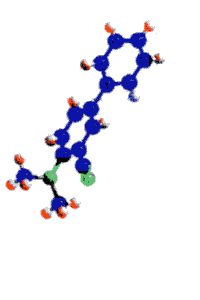
Research is funded by: Eastman-Kodak, USA
Electron Crystallography: Electron crystallography involves the use of the electron microscope to obtain 2- and 3-dimensional diffraction patterns from nanocrystals. Such data are notoriously difficult to deal with because the measurements are subject to severe systematic errors and because only part of the diffraction pattern is usually accessible. The systematic errors arise from dynamical scattering in which the fundamental kinematic relationship breaks down because of the very strong interaction of electrons with matter to give dynamical data. The accessibility of the diffraction pattern arises from experimental constraints. Maximum entropy methods are capable of determining the structures of molecules from high-resolution electron microscopy data using both the relatively low resolution focused images and the high resolution diffraction pattern from micro-crystallites and thin films. The method has been used to break the 1Å resolution barrier by obtaining an electron density map and image of perchlorocoronene from electron microscopy and diffraction data The ME formalism has been used for other structures of interest to materials scientists in the fields of non-linear optical materials and alloys. These are among the most complex molecules studied at atomic resolution by electron diffraction. It can be difficult to verify proposed models with highly dynamical data, but a start has been made on this process with restrained and constrained least-squares procedures.
 |
Structure of 4-dimethyl-3-cyanobiphenyl as determined
by 3-D electron diffraction.
|
|
Research is funded by: Eastman-Kodak, USA |
The problem with missing data arises from the physical limitations within the microscope. Once the sample has been tilted to say 60° then the platform on which it sits starts to interfere with the electron beam, thus making it impossible to collect data from the higher angles. One way round this is to use maximium entropy to help predict the missing reflections and phases.
The process of refinement in crystallography is used to validate your proposed model. For many years this has been a standard requirement in X-ray experiments, now we have developed a methodology to allow the same least squares programs, such as SHELX-L to refine 2 and 3-D electron crystal structures - a process sometimes thought to be impossible due to the sparseness of the data and the low parameter: reflection ratio.
References for Electron Diffraction